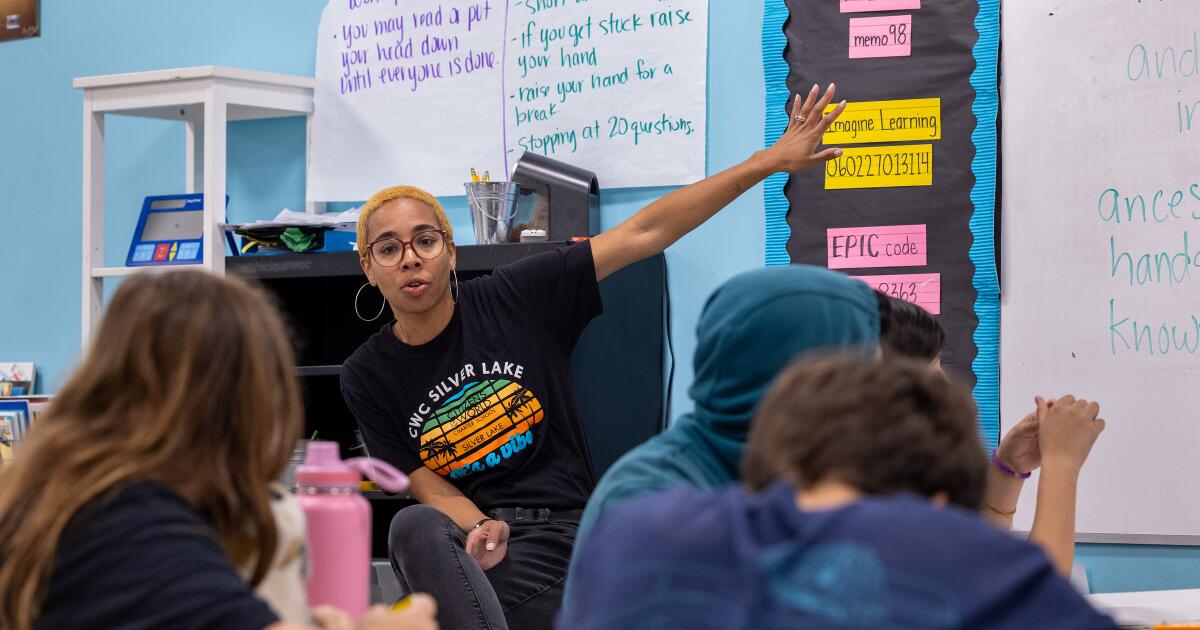What do you think of when you hear the words climate change, Brittany Jefferson asked her fifth-graders. She moved around her classroom at Silver Lake’s Citizens of the World Charter School making eye contact with each student as she talked.
“World is getting hotter,” someone shouted.
“Man-made,” another volunteered.
“More water in the oceans.”
With her class now on topic, Jefferson dimmed the lights and flipped on a slideshow she’d created with data on rising temperatures. Even though summer break was nearing, her students were attentive. Earth “has a fever” from burning fossil fuels, she told her students, noting that climate change affects poor people disproportionately.

Ira Lefelt answers a question in Brittany Jefferson’s class at Citizens of the World Charter School.
(Brian van der Brug / Los Angeles Times)
The science class ended with her reading aloud a picture book on environmental damage from fossil fuels.
Introduced to climate change as a teenager when she watched Al Gore’s documentary “An Inconvenient Truth,” Jefferson was a classroom teacher when she came to believe the next generation, including many of her students, were clueless about the crisis.
Initially, in small ways, she began including the idea of caring for the natural world in her classroom. When the kids responded, she grew more ambitious for her students at the Title I school, where 55% of the students qualify for free or reduced-priced lunches.

Our Climate Change Challenge
Creating their own curriculum
California wants climate education for its students. Meet some of the teachers, schools and nonprofits making it happen.
Climate lessons were available online at Subject to Climate. But they weren’t always the right fit, so Jefferson created her own during personal time on evenings and weekends. During the COVID-19 pandemic, she teamed up with the two other fifth-grade teachers at her school to create comprehensive climate lessons that could be incorporated in every subject they taught. “The administration was supportive of what we did,” Jefferson said.
No matter the subject, if she could relate it to the degrading environment, she said, her students tuned in.
For a language arts lesson on persuasion, she gave her class the details of the then-pending Willow oil drilling project in Alaska. Using that information, students wrote letters to President Biden either supporting or opposing the project, and she mailed the packet of letters to the White House.
For a math lesson, her class studied the Great Pacific Garbage Patch in the North Pacific Ocean. How many Californias would fit into that area? How many New Jerseys? Colorados?

For a math lesson, Brittany Jefferson’s class studied the Great Pacific Garbage Patch in the North Pacific Ocean.
(Brian van der Brug / Los Angeles Times)
After five years, working hundreds of hours to create climate-oriented curriculum, Jefferson left the classroom before the start of the 2024-25 school year. She plans to work full time creating lessons that develop climate literacy in grade-school students.
Through her network of teachers, she said she’s confident that, at least in Los Angeles, there is interest in developing climate literacy at all levels. She’s hoping some of the lessons she is creating will find their way into those classrooms.
